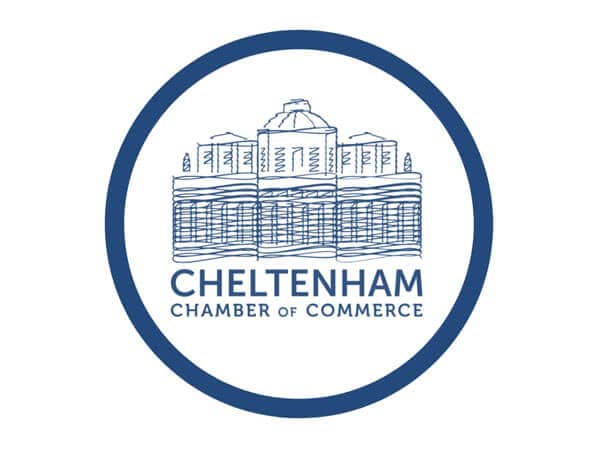Since 1902 the Cheltenham Chamber of Commerce has helped the town’s business community thrive through collaboration and partnership.
It has done so through periods of prosperity and recession, through wars and most recently through a pandemic. Today, the Chamber remains what its Chief Executive, Michael Ratcliffe, describes as “a family of businesses.” Members range from FTSE 100 companies to individual entrepreneurs, and it is run entirely by volunteers with significant senior business experience across a range of disciplines and a super-efficient administrator.
But, if you think of a group of stuffy folk sitting around a big table in a wood-panelled room, think again.
From helping businesses with rising energy costs to championing local procurement for major developments like the Golden Valley and the A417 “Missing Link;” from looking at how businesses can work better with local schools and colleges to encourage local talent and employment to facilitate businesses’ CSR activities with our local charities, the Chamber is very much focussed on the future.

A History of the Chamber
After 120 years, we thought we should record the Chamber’s history and we are very grateful to a history student, Theo Hughes, for compiling this study. It is a fascinating parallel to the town’s Commercial Timeline, produced by our local history society and featured elsewhere on this site.
From helping to set up a forerunner to Cheltenham’s Festivals and the first tourist information service to appointing its first female president in 1944 and campaigning for the local hospital, the Chamber has stayed relevant for a remarkably long period.
How did Chambers of Commerce Begin?
Although the first ‘Chamber of Commerce’ was founded in Marseilles in 1599, it took until the 1760s and 1770s for the first British incarnations to arise. Associations that would eventually become ‘Chambers’ were formed by local merchants on both sides of the Atlantic to protest against the laws that led to the American Revolution. The associations in Liverpool, Manchester, Glasgow, and just as well in New York, Boston, Charleston, and Jamaica were “deeply dissatisfied with the unpopular laws, treaties, taxes, policies imposed by a central government hell-bent on outdated and monopolistic mercantilism.”
Even once the open rebellion had begun in the Thirteen Colonies, the British associations nonetheless survived, consolidating together and often growing to fill the void left by now-absent American merchants. The first official Chamber of Commerce was then founded in Glasgow in 1783, and with the loss of the Atlantic-based dispute at the core of their original purpose, the Chambers began diffusing further inland. After the middle of the 19th century and the Repeal of the Corn Laws, they became ubiquitous and influential across nearly every town and city in Britain.
Cheltenham’s First Chamber
Cheltenham, having emerged from obscurity only in the 18th century, was a relative latecomer to the wider Chamber movement in Britain. Although not an industrial town, its retail services were buoyed by the success of its spas and racecourses, turning the area into a prosperous shopping centre by the early 20th century. Some of the local merchants became eager to organise in their shared interests and especially eager for the prestige of possessing a Chamber of Commerce rather than a trade association, which Cheltenham would have ordinarily been expected to form as a town.

It was then-MP James Agg-Gardner, the son of a wealthy local brewer, who would propose, found, and then lead the Cheltenham Chamber of Commerce as its first President, albeit with breaks, from its creation in 1902 to his eventual death in 1928. By that time, Agg-Gardner was the oldest serving MP in the Commons, known for his gentlemanliness and implicit homosexuality, as well as his early support of women’s suffrage stretching back to the 1870s. He sponsored the bill that finally conferred borough status on Cheltenham, and by the end of his life was referred to as Cheltenham ‘personified’.
The First and Second World Wars
Through his presidency and beyond, the Chamber established itself as one of Cheltenham’s largest and most influential organisations. In the First World War, the Chamber supported the military in their recruitment drive and donated an ambulance to the Red Cross. It also created a fund for Prisoners of War held in the Cheltenham area, supported with both Chamber resources and public donations, for supplying them with food parcels and clothing. After the war, the Chamber planned and organised the first Cheltenham Competitive Festival – what is now known as the Cheltenham Festival of Performing Arts – with immediate success. It devised and financed an Information Bureau for the town, which massively improved the accessibility of local hotel accommodations for tourists and visitors, as well as helping promote Cheltenham’s celebrity concerts, floral fetes, and Dig for Victory shows.

By 1941, the Chamber was known as one of Cheltenham’s ‘Three Chains of Office’ – alongside the Mayoralty and Rotary Club – due to the prevalence of its leaders also having held those roles, and vice versa. A tradition that continues until this day. In 1944, the Chamber elected its first female President, E.K. Bayliss. By that time, the Chamber had a membership of over 250 firms and individuals, whereas in 1906 it had only 60.
During the period of Anglo-German tension preceding the Second World War, the Chamber worked in collaboration with the Gloucester Chamber of Commerce to gather Recruits for the Territorial Army. Four days after the outbreak of war, the Chamber met and agreed to heavily lobby the Town Council for preparing Cheltenham for raids, blackouts, early closures, and general economic hardship.
Post-War Consolidation
After the conclusion of the war, the Chamber enjoyed an uneventful though prosperous latter century. It continued to act as a centre for the local business community, riding the wave of its early successes in a new normalcy.
Around the turn of the century, the Cheltenham Chamber merged with the Gloucester Chamber of Commerce to form the Gloucestershire Chamber of Commerce. Due to internal disagreements, the Cheltenham Chamber left the merger and reformed in 2006.
The Chamber has always maintained strong connections with local institutions such as the Borough Council, University, Cheltenham Trust and more recently with the BID (Business Improvement District), GFirst LEP (Local Enterprise Partnership) and the Growth Hub. It has regular updates with members of local and central government and in the past, has hosted talks from the likes of MPs Vince Cable. Nick Clegg and Michael Howard.
In 2013, the Chamber helped to set up the REACH campaign – ‘Restore Emergency At Cheltenham Hospital’ – to oppose plans to downgrade Cheltenham’s hospital services. Supported by our local MP, it has been successful in preventing decisions such as downgrading the A&E Department into a Minor Injuries and Illnesses Unit overnight and later downgrading the whole hospital into a day-case-only facility.












